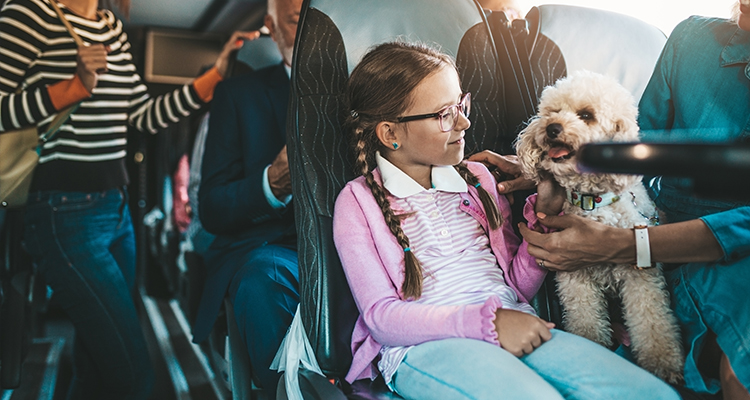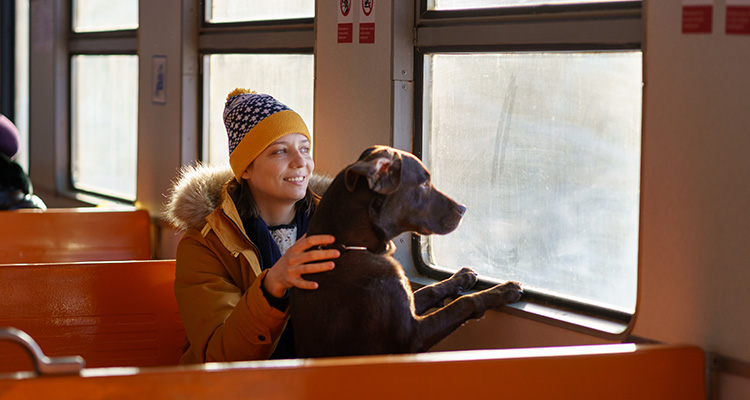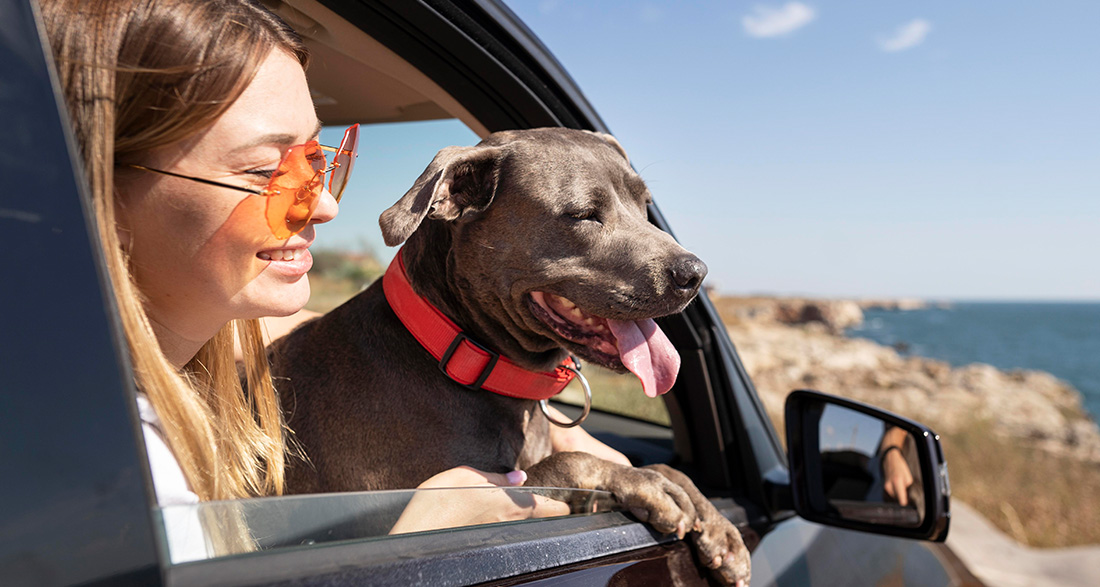Whether on vacation or during a move, traveling with a dog can be a small challenge, especially the first time, as there is a lot to consider and plan. Here, you can read about what you should consider in advance, the advantages and disadvantages of different types of travel, and how to make traveling as stress-free as possible for both you and your dog. Additionally, you’ll receive some practical tips to ensure that nothing goes wrong during your trip.
General preparations before the vacation
For a pleasant and relaxing vacation with your dog, proper preparation is essential. Before booking your vacation, clarify a few fundamental things:
- Check whether dogs are allowed in the hotel or vacation rental. If it’s not clear on the accommodation’s website, simply call and inquire.
- Examine if the surroundings of the accommodation are dog-friendly. Is your dog allowed on the beach or by the lake? Are there parks, meadows, or forests nearby for walks? Can you take your dog on planned excursions? Tip: Many regions in Europe have travel guides specifically for dog owners.
- If you plan to travel abroad, check the entry requirements for dogs. What documents does your dog need?
- Update your dog’s vaccinations. A current rabies vaccination is mandatory when traveling abroad. Other vaccinations may be advisable depending on the destination. Consult your veterinarian for guidance.
Ensure that your dog is temperamentally prepared for travel to a new environment. Your dog should be relaxed around crowds and various stimuli, and well-behaved so as not to disturb others.
Traveling by car with a dog

Traveling in your own car is usually less stressful and more relaxing than by train since the dog often already knows it from everyday life. Nevertheless, take it slow and introduce your dog to car travel gradually if not done already.
Let your dog sit in the open car first, feed them their favorite food in the car, and, when they are completely relaxed, close the car and start the engine while stationary. Once your dog is accustomed to the engine’s vibrations while stationary, gradually take short trips. Remember to praise and reinforce positive behavior during each step of acclimation.
WARNING
Never leave your pet alone in the car, especially in warm or hot weather. Even with the windows cracked, the temperature inside a car can quickly become dangerously high.
Before long car journeys, make sure to exercise and engage your dog beforehand, and avoid feeding them right before the journey.
Ensure that your dog is properly secured in the car! Use a suitable transport box for the trunk or a certified car harness for the back seat.
Pros and Cons of Car Travel with Dogs
Pros
- Convenient, especially if you own a car.
- Less expensive than other modes of transportation.
- More control over the frequency of stops.
Cons
- Long-distance trips take longer
- If you don’t own a car, it can get expensive
- You must ensure all pit stops are pet-friendly as well as any hotels you will stay in along the way
Bus Travel with a Dog

Traveling with a pet on a bus poses additional challenges compared to car or train travel, mainly due to the stringent pet policies enforced by many bus companies. For instance, Greyhound strictly prohibits any pets, permitting only service animals on board. It is crucial to thoroughly review the pet policy of the chosen bus company before securing your bus tickets. In the event of finding a pet-friendly bus company, anticipate potential requirements such as making a prior reservation for your pet and paying a specified fee.
Typically, bus companies mandate that pets travel in a carrier or crate. In some urban settings with public transportation, certain cities may permit pets in carriers or bags. Select a carrier that aligns with your pet’s size and comfort, ensuring it complies with the stipulations of the bus company.
Several buses incorporate periodic stops during the journey, offering opportunities for your pet to take a break and stretch. Prioritize checking the schedule in advance to ensure adequate breaks for your pet. Avoid scheduling a trip that necessitates your pet to remain confined for a duration longer than their typical ability to hold their bladder, which is generally around six to seven hours at most.
Arriving at the bus station ahead of time is advisable to allow ample time for check-in and settling your pet. Adhere to the guidelines provided by the bus company concerning boarding procedures and placing your pet’s carrier in the designated area.
If your pet is unaccustomed to car travel, a bus journey may induce additional stress. Allocate some time before the bus trip to familiarize your pet with car rides.
Pros and Cons of Bus Travel with Pets
Pros
- Your pet stays with you in a carrier.
- Stops may allow for potty breaks.
- Less expensive than air travel.
Cons
- Your pet stays with you in a carrier.
- Stops may allow for potty breaks.
- Less expensive than air travel.
Traveling by train with a dog

If you intend to travel by train with your dog, one thing is particularly important: The journey to the vacation destination should not be your dog’s first train experience. Proper preparation is key:
- Introduce your dog to a muzzle well before the journey, as many trains require dogs to wear one. It’s crucial that your dog can pant while wearing it, so the muzzle should be sufficiently large and deep.
- Weeks before the journey, take your dog to the train station regularly to acclimate them to the hustle and bustle.
- Before using public transportation, start by waiting at the station and observing the train stopping and starting.
- Gradually take short trips, preferably just one station at first.
- Stay calm and composed during the process, reassuring your dog with a calm voice and rewarding them with treats during the journey.
- If your dog exhibits signs of stress such as panting, sweaty paws, restlessness, trembling, or drooling, end the trip immediately and proceed with the acclimation more slowly and gently.
Before the train journey, ensure your dog gets some exercise and tires them out, for example, with search games, so they can rest comfortably during the trip.
Shortly before the journey, refrain from feeding your dog, and limit the number of treats during the journey to minimize the risk of motion sickness.
In the train, provide a secure resting place, ideally under the seat or in a corner but not in the aisle where many people pass. Place their familiar blanket, which smells like home, and ensure that strangers do not pet them.
Pros and Cons of Train Travel with Dogs
Pros
- You stay with your pet in a carrier.
- More affordable than flying.
Cons
- Trips may take longer.
- Some trains don’t allow large dogs.
- Potential disturbance to other passengers.
Flying with a dog

In general, flying with a dog should be avoided whenever possible. It puts the dog in an extremely stressful situation, especially if they weigh over 5 kilograms, as they often have to travel in the dark, cold, and very loud cargo hold. If flying is unavoidable, consider the following important points:
- Book a nonstop flight to prevent additional stress from transfer during layovers.
- Inform your airline in advance that you plan to bring your dog and inquire about the applicable guidelines for handling animal transport.
- Thoroughly research the entry requirements of the destination country, including whether your dog needs to go into quarantine and what vaccinations are required.
- Obtain a sturdy, escape-proof, and adequately sized transport box that complies with the airline’s regulations. The dog should be able to stand and turn around in it. Keep in mind that your dog may panic and attempt to dismantle the box, so it must be secure.
- Acquaint your dog with the box weeks before the flight, ensuring they feel comfortable and view it as a safe retreat.
- Visit the airport with your dog several times before the flight to acclimate them to the atmosphere and the presence of many people.
- Consult with your veterinarian about whether your dog can be lightly sedated for the journey or which herbal calming aids, such as Bach flowers, are recommended. A calming collar emitting relaxation pheromones for the dog may also be useful.
On the day of the flight, ensure that your dog gets sufficient exercise, preferably with a calm walk and many search games. Avoid throwing games that may overly excite the dog, as they will then have to board the plane in an agitated state. Also, refrain from feeding your dog right before the flight to prevent motion sickness.
It’s essential to allocate enough time for everything on the travel day, especially for the journey to the airport and the check-in, to avoid subjecting the dog to additional stress.
After the flight, release your dog from the box immediately and do not be upset if they bark or jump around; they are likely disoriented. Therefore, ensure that they can quickly settle down and sleep in the new accommodation to process everything.
Pros and Cons of Plane Travel with Pets
Pros
- Can cover long distances quickly.
Cons
- Most expensive option.
- Cargo hold can be unsafe for some pets.
- High stress levels for some pets.
Pet-Friendly Transportation Resources
If you plan to travel with your pet in the coming months, start planning now with the resources below.
Trains
Airlines
Bus Lines
Public Transportation
- Metropolitan Transportation Authority (NYC)
- Washington Metropolitan Area Transit Authority (DC)
- Chicago Transit Authority
- Massachusetts Bay Transportation Authority (Boston area)
- MARTA (Atlanta)
- Los Angeles Metro
- Muni San Francisco
- Regional Transportation District (Denver area)
- IndyGo (Indianapolis)
- King County Metro (Seattle)


